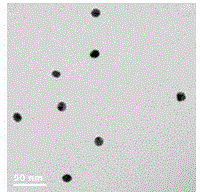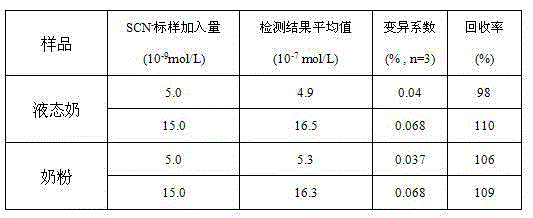Method for detecting thiocyanate ion based on fluorescence resonance energy transfer
A technology of fluorescence resonance energy and thiocyanate, which is applied in the field of analysis, can solve the problems of time-consuming, high detection cost, and inability to be widely used, and achieve high-sensitivity and sensitive detection effects
- Summary
- Abstract
- Description
- Claims
- Application Information
AI Technical Summary
Problems solved by technology
Method used
Image
Examples
Embodiment 1
[0022] A method for detecting thiocyanate ions based on fluorescence resonance energy transfer, the specific steps are as follows:
[0023] (1) Preparation of gold nanosolution glue:
[0024] Wash all the glassware, soak it with freshly prepared aqua regia, wash it with ultrapure water and dry it, and prepare the gold nanosolution glue by trisodium citrate reduction method: add 1 mmol / L chloroauric acid to a 250 mL three-necked flask 100 mL of aqueous solution was heated to boiling under full stirring, and 38.8 mmol / L trisodium citrate aqueous solution was quickly added under stirring, so that the golden yellow chloroauric acid aqueous solution turned wine red within 2 minutes, continued to condense and reflux for 15 minutes, and cooled naturally to At room temperature, the gold nano-sol was prepared, and stored at 4°C for subsequent use;
[0025] (2) Synthesis of fluorescein-gold nanocomposites:
[0026] Put 30 μL at a concentration of 1.0 x 10 -5 mol of fluorescein was ad...
PUM
 Login to View More
Login to View More Abstract
Description
Claims
Application Information
 Login to View More
Login to View More - R&D
- Intellectual Property
- Life Sciences
- Materials
- Tech Scout
- Unparalleled Data Quality
- Higher Quality Content
- 60% Fewer Hallucinations
Browse by: Latest US Patents, China's latest patents, Technical Efficacy Thesaurus, Application Domain, Technology Topic, Popular Technical Reports.
© 2025 PatSnap. All rights reserved.Legal|Privacy policy|Modern Slavery Act Transparency Statement|Sitemap|About US| Contact US: help@patsnap.com



